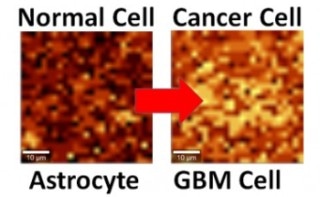Dec 20 2016
What can’t graphene do? You can remove “detect cancer” from that list.
Researchers from the University of Illinois at Chicago have shown that they can distinguish a single hyperactive cancerous cell from a normal cell by interfacing brain cells onto graphene. This could lead to the development of a simple, noninvasive tool for early diagnosis of cancer.
This graphene system is able to detect the level of activity of an interfaced cell,” says , who headed the research together with Ankit Mehta, assistant professor of clinical neurosurgery in the UIC College of Medicine.
Graphene is the thinnest known material and is very sensitive to whatever happens on its surface. This nanomaterial is made of a single layer of carbon atoms, which are linked together in a hexagonal chicken-wire pattern, and all the atoms share a cloud of electrons that move freely about the surface.
The cell’s interface with graphene rearranges the charge distribution in graphene, which modifies the energy of atomic vibration as detected by Raman spectroscopy.
Vikas Berry, associate professor and head of chemical engineering at UIC, co-head researcher
According to Berry, the atomic vibration energy in the crystal lattice of graphene differs depending on whether it’s is in contact with a normal cell or a cancer cell, because the cancer cell’s hyperactivity causes a higher negative charge on its surface and the discharge of more protons.
 Normal and cancerous brain cells interfaced with graphene show different activity levels under Raman imaging. Credit: UIC/Vikas Berry
Normal and cancerous brain cells interfaced with graphene show different activity levels under Raman imaging. Credit: UIC/Vikas Berry
“The electric field around the cell pushes away electrons in graphene’s electron cloud,” he said, which changes the carbon atoms’ vibration energy. He also stated that the change in vibration energy can be detected by Raman mapping with a resolution of 300 nm, enabling the characterization of the activity of a single cell.
The research, published in the journal ACS Applied Materials & Interfaces, explored cultured human brain cells and compared normal astrocytes to their cancerous counterpart, glioblastoma multiforme, the most aggressive type of malignant brain tumor. The technique is now being examined in a mouse model of cancer, with results that are “very promising,” Berry said. Tests with patient biopsies would be further down the road.
Once a patient has brain tumor surgery, we could use this technique to see if the tumor relapses. For this, we would need a cell sample we could interface with graphene and look to see if cancer cells are still present.
Vikas Berry, associate professor and head of chemical engineering at UIC, co-head researcher
The same technique may also work to distinguish between other types of cells or the activity of cells. “We may be able to use it with bacteria to quickly see if the strain is Gram-positive or Gram-negative,” Berry said. “We may be able to use it to detect sickle cells.”
Earlier this year, the team launched nanoscale ripples in graphene, causing it to act differently in perpendicular directions, useful for electronics. The researchers wrinkled the graphene by wrapping it over a string of rod-shaped bacteria and then vacuum-shrinking the germs.
We took the earlier work and sort of flipped it over. Instead of laying graphene on cells, we laid cells on graphene and studied graphene’s atomic vibrations.
Vikas Berry, associate professor and head of chemical engineering at UIC, co-head researcher
Co-authors of the study include Bijentimala Keisham and Phong Nguyen of UIC chemical engineering and Arron Cole of UIC neurosurgery. UIC provided funding for the study.